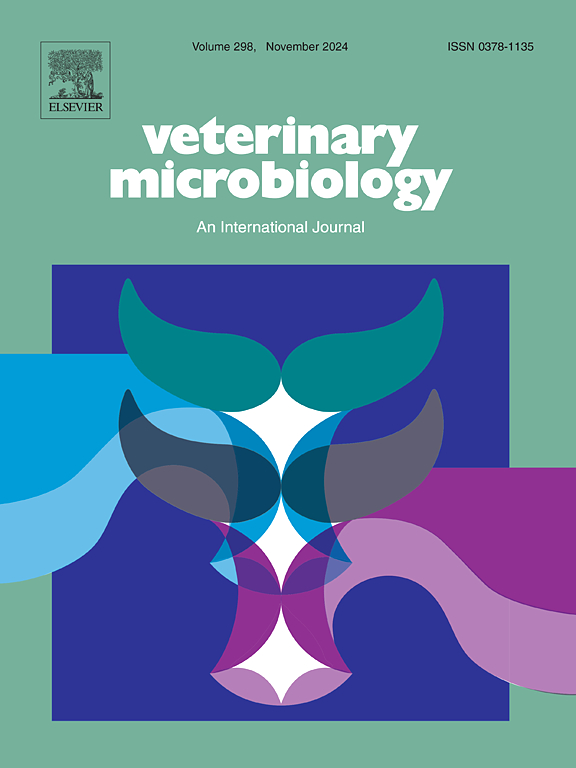Duck plague virus ICP27 protein suppresses IFN-β production by dual targeting of DNA- and RNA-sensing pathways
IF 2.7
2区 农林科学
Q3 MICROBIOLOGY
引用次数: 0
Abstract
Duck plague virus (DPV), an alphaherpesvirus causing severe economic losses in global waterfowl industries, adopts sophisticated strategies to subvert host antiviral immunity. Here, we identify DPV ICP27 as a pivotal immune evasion protein that concurrently inhibits both DNA (cGAS-STING) and RNA (RIG-I/MDA5-MAVS) innate immune sensing pathways—a novel function unreported in avian herpesviruses. Through co-transfection and infection assays in duck embryo fibroblasts (DEFs), we demonstrate that ICP27 suppresses key immune sensors' transcriptional and protein expression levels (STING, RIG-I) and the transcription factor IRF7. Co-immunoprecipitation confirms ICP27 binds to IRF7, impairing interferon regulatory functions, impairing interferon regulatory functions. Crucially, infection with ICP27-knockout DPV (DPV-ΔICP27) significantly enhances IFN-β, IL-6, Mx, and OASL expression compared to wild-type virus. Phylogenetic analyses reveal conserved yet species-specific functional divergence of ICP27 across herpesviruses. Our findings identify a unique "multi-target cooperative suppression" mechanism employed by DPV, which enhances our understanding of avian herpesviral immune evasion and offers potential targets for developing novel antiviral strategies.
鸭瘟病毒ICP27蛋白通过双重靶向DNA和rna感应途径抑制IFN-β的产生
鸭瘟病毒(DPV)是一种给全球水禽产业造成严重经济损失的甲型疱疹病毒,它采用复杂的策略来破坏宿主的抗病毒免疫。在这里,我们发现DPV ICP27是一种关键的免疫逃避蛋白,它同时抑制DNA (cGAS-STING)和RNA (RIG-I/MDA5-MAVS)先天免疫感知途径,这是一种未在禽疱疹病毒中报道的新功能。通过鸭胚成纤维细胞(DEFs)的共转染和感染实验,我们发现ICP27抑制关键免疫传感器(STING、RIG-I)的转录和蛋白表达水平以及转录因子IRF7。共免疫沉淀证实ICP27与IRF7结合,损害干扰素调节功能,损害干扰素调节功能。关键是,与野生型病毒相比,icp27敲除DPV (DPV-ΔICP27)感染显著提高了IFN-β、IL-6、Mx和OASL的表达。系统发育分析揭示了ICP27在疱疹病毒中保守但物种特异性的功能差异。我们的发现确定了DPV采用的独特的“多靶点协同抑制”机制,这增强了我们对禽疱疹病毒免疫逃避的理解,并为开发新的抗病毒策略提供了潜在的靶点。
本文章由计算机程序翻译,如有差异,请以英文原文为准。
求助全文
约1分钟内获得全文
求助全文
来源期刊

Veterinary microbiology
农林科学-兽医学
CiteScore
5.90
自引率
6.10%
发文量
221
审稿时长
52 days
期刊介绍:
Veterinary Microbiology is concerned with microbial (bacterial, fungal, viral) diseases of domesticated vertebrate animals (livestock, companion animals, fur-bearing animals, game, poultry, fish) that supply food, other useful products or companionship. In addition, Microbial diseases of wild animals living in captivity, or as members of the feral fauna will also be considered if the infections are of interest because of their interrelation with humans (zoonoses) and/or domestic animals. Studies of antimicrobial resistance are also included, provided that the results represent a substantial advance in knowledge. Authors are strongly encouraged to read - prior to submission - the Editorials (''Scope or cope'' and ''Scope or cope II'') published previously in the journal. The Editors reserve the right to suggest submission to another journal for those papers which they feel would be more appropriate for consideration by that journal.
Original research papers of high quality and novelty on aspects of control, host response, molecular biology, pathogenesis, prevention, and treatment of microbial diseases of animals are published. Papers dealing primarily with immunology, epidemiology, molecular biology and antiviral or microbial agents will only be considered if they demonstrate a clear impact on a disease. Papers focusing solely on diagnostic techniques (such as another PCR protocol or ELISA) will not be published - focus should be on a microorganism and not on a particular technique. Papers only reporting microbial sequences, transcriptomics data, or proteomics data will not be considered unless the results represent a substantial advance in knowledge.
Drug trial papers will be considered if they have general application or significance. Papers on the identification of microorganisms will also be considered, but detailed taxonomic studies do not fall within the scope of the journal. Case reports will not be published, unless they have general application or contain novel aspects. Papers of geographically limited interest, which repeat what had been established elsewhere will not be considered. The readership of the journal is global.
 求助内容:
求助内容: 应助结果提醒方式:
应助结果提醒方式:


